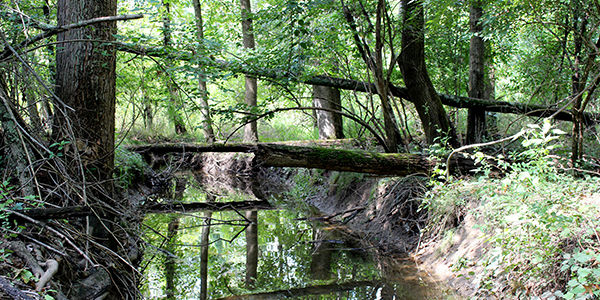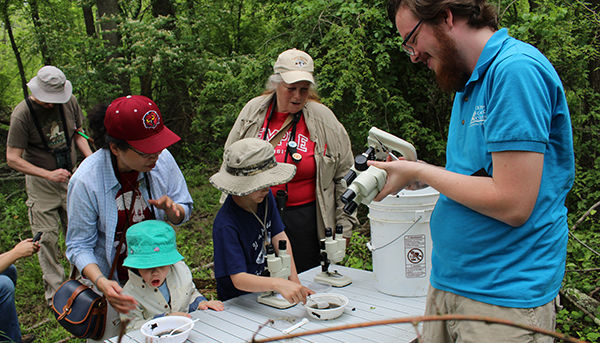Now it's your turn! It's time to get hands on with World Water Day through fun activities you can do online and at home. Learn how to wade into a stream and collect your own insects, join the conversation and talk about what water means to you, create your own horseshoe crab hat or get involved in citizen science part participating in projects throughout the region!
Simple Water Actions You Can Take for World Water Day

The UN Department of Social and Economic Affairs (UN DESA) has created a resource of simple actions and activities you can take to help accelerate change and raise awareness of the water and sanitation crisis.
Try these two for World Water Day 2024:
The Lazy Person’s Guide to Saving Water: as the title suggests, this is a set of suggestions for action that people can take with minimal effort, although there are also ideas for the more energetic among us!
Test your water knowledge: Play Kahoot, a quiz based on the water and sanitation crisis, helping you focus your mind on the key issues and share interesting facts with your contacts.
Check out more simple WaterActions here.
FunScienceDemos from the College of Science and Technology
Temple University's College of Science and Technology offers a wonderful series of FunScienceDemos in cooperation with TuTeach. With new videos all the time, FunScienceDemos brings engaging demonstrations in a broad range of Earth/Space Science, Physical Science, Life Science, Science Practices and Engineering topics right into your classroom or home. FunScienceDemos is just one part of the FunScienceNetwork, of Temple University's College of Science & Technology, a collection of Next Generation Science Standards supported free and original content for K-12 teachers & students & parents. For teaching resources such as writing prompts, reading, and math on relevant science materials, visit FunScienceSupport.
These videos are used with permission from the College of Science and Technology, TuTeach and the incredible FunScienceDemos team.
Erosion and Soil
In this video from the College of Science and Technology's FunScienceDemos, Jared explains why erosion occurs more slowly when soil is paired with leaf debris or plants, in this simple demonstration you can try at home or in class!
Water Breaks Down Rocks
Jared introduces the concept of weathering, and gives us three examples you can try at home that demonstrate the big idea today from College of Science and Technology's FunScienceDemos.
Water Cycle in a Bag
In this video from the College of Science and Technology's FunScienceDemos, Jared creates a water cycle and makes it rain in a plastic bag (and you can too)! Will the blue water make blue rain?
Water Science for Little Learners: The Shape of Water
Let’s talk about water! Have you ever wondered if water had a shape? Using a variety of objects, from circles to rectangles to cylinders, Cheryl Duffy, Director of Rainbow Academy, explores whether water will take the shape of the various vessels it’s poured into!
Water Science for Little Learners: Sink or Float?
When it comes to water, some things are able to float right on top, while others sink right to the bottom! What do you think will happen to an orange, or a pencil or a leaf or a spoon? Join Cheryl Duffy, Director of Rainbow Academy, to find out!
Water Science for Little Learners: Water Music
Did you know water can be a musical instrument? Using different amounts of water will result in different tones! Join Cheryl Duffy, Director of Rainbow Academy, and learn how to make beautiful music with water!
Water Science for Little Learners: You Can Make a Rainbow!
How do you make a rainbow inside your house? With water of course! Let’s see if we can do an experiment with water to make our own rainbow. Using cups, a little food coloring and strips of paper towels, Cheryl Duffy, Director of Rainbow Academy, will show you how to make all of the colors of the rainbow!
Make Your Own Observations

If you happen to be on campus observing wildlife, studying the plants and trees, or simply wandering in our gardens, why not engage in a little citizen science while you're here? You might come across any number of animals that depend on the creeks running through campus! Record your observations for the Temple Ambler Field Station and the Ambler Arboretum's new project page on iNaturalist! Any iNaturalist observation taken at the Ambler Campus will be automatically uploaded, which will prove invaluable for future campus research! iNaturalist shares your findings with scientific data repositories like the Global Biodiversity Information Facility to help scientists find and use your data. All you have to do is observe.
How Can You Help Protect Source Water?

Communities, citizen groups, and individuals can take an active role in protecting their drinking water sources from contamination. Resources from the United States Environmental Protection Agency provides information about source water protection and steps you can take at the local level to protect your drinking water. Content used with permission from EarthFest Presents: Celebrating the Earth partner U.S. EPA Region III.
DRBC: Create Your Own Horseshoe Crab Hat!
Let's make a horseshoe crab hat with the Delaware River Basin Commission! Horseshoe crabs are an important species that live in the ocean and visit the shores of the Delaware Bay each spring to lay their eggs. In fact, they do this here more than anywhere else on the East Coast! Visit here to download the template and follow along!
DRBC: Create a Freshwater Mussle Hat!
What's better that one hat? Two! In this video from the Delaware River Basin Commission, join a brother and sister team as they make their own freshwater mussel hats! Freshwater mussels are an important part of a river's ecosystem, stabilizing streambeds and cleaning the water they live in! Visit here to download the template and craft along!
We Can All Lend a Hand!

If you're seeking ways that you can engage in science and environmental projects in your community, SciStarter is an excellent repository of thousands of possibilities! SciStarter is an online community dedicated to improving the citizen science experience for project managers and participants. More than 3,000 projects and events are searchable by location, scientific topic, and age level. SciStarter also supports researchers in managing projects, including best practices for engaging participant partners. SciStarter also provides a great overview of citizen science. Here are just a few SciStarted projects to help you become a citizen scientist and a water quality champion!
Wissahickon Creek Watch Program
Wissahickon Trails is looking for a dedicated group of volunteers to help monitor the health of the Wissahickon Creek and its tributaries! The Citizen Scientists will be trained in water quality monitoring, primarily using visual assessments. Each volunteer is assigned a one to two mile section on public land from the headwaters in North Wales to Fairmount Park. They will submit data for algae cover, animal observations, erosion, percent shade and a myriad of other indicators of stream health. Additionally, there will sub-group of Creek Watchers known as the “Wading Team” that will take samples from the stream to determine the amount of nutrients, dissolved oxygen and water temperature.
Craywatch
Invasive self-cloning crayfish are on their way to a stream or lake near you! Your help is needed to monitor our waterways for the invasion of new species of crayfish. High on the priority list is Marmokrebs, a species that reproduces asexually – making it an extremely successful intruder in pristine ecosystems. Let’s make sure we know exactly where this and many other potentially invasive species are headed! Take pictures of crayfish and tell us where and when you found it. Invasive crayfish have had devastating effects in many freshwater ecosystems across the world, often driving local fish and invertebrate species to extinction.
Leaf Pack Network
Presented by the Stroud Water Research Center, the Leaf Pack Network is an international network of teachers, students, and citizen monitors investigating their local stream ecosystem. Through the Leaf Pack Experiment, monitors use tree leaves and aquatic insects to determine the health of their stream and to understand its ecology. Individuals participating in the Leaf Pack Experiment and Leaf Pack Network® engage in the full process of designing an experiment, conducting research and communicating their results. Leaf Pack can also easily be implemented into any curriculum and fulfills many state and national science standards. Watch your students become empowered and energized learning about their local watershed!
Dragonfly Migration
The Migratory Dragonfly Partnership needs your help to better understand dragonfly migration in North America. Although it spans three countries and has been documented since the 1880s, North American dragonfly migration is still poorly understood, and much remains to be learned about migratory cues, flight pathways, and the southern limits of overwintering grounds. Become part of an international network of citizen scientists and help monitor the spring and fall movements of the five main migratory species in North America, or report on these species throughout the year at a pond or wetland of your choice.
Stream Selfie
What’s in your water? We all have the right to know if the streams running through our backyards and neighborhood parks are safe. But there is an alarming lack of up-to-date information about water quality across the country. Stream Selfie, presented by the Izaak Walton League of America, is here to bridge that information gap. Stream Selfie connects you with thousands of other citizen scientists to paint a picture of streams across America. Simply snap a pic of your local stream and share it. Your photo is step one in the effort to check the health of every stream in the country — far more streams than state and local agencies have the resources to check!
Creek Freaks — Engaging Youth in Water Quality
Want to start an outdoor education program but don’t know where to start? Looking for hands-on activities for your classroom or an existing youth program? Have you been looking for a way to share your love of the outdoors with kids in your community? Creek Freaks could be the answer! Creek Freaks (presented by the Izaak Walton League of America) are kids making a splash to help the environment by monitoring water quality. Each session takes youth outside to explore local streams and learn how healthy trees, shrubs, and grasses protect clean water and wildlife. Kids of all ages are then empowered as local stream experts and are encouraged to continue advocating for and working to improve water quality.
FreshWater Watch
FreshWater Watch is the Earthwatch’s global research project, which aims to involve at least 100,000 people in a program to research and learn about fresh water. The purpose of FreshWater Watch is to safeguard the quality and supply of fresh water, our planet’s most precious and vital resource. Participants have the opportunity to become citizen scientists and take an active role in scientific data gathering. As a citizen scientist, you will join a global community working together to promote freshwater sustainability.
Mosquito Byte!
Mosquito Byte! Is a smartphone app developed by North Carolina State University to report mosquito bites. The user is rewarded with a fact about mosquitoes, and the bite report is displayed in (almost) real time on a map of the world. The more people use it, the more we know about when and where there are biting mosquitoes.
